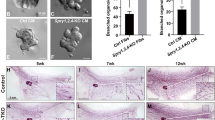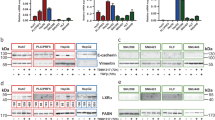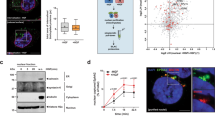Abstract
Hepatocyte growth factor/scatter factor (HGF/SF) induces scattering and morphogenesis of epithelial cells through the activation of the MET tyrosine kinase receptor. Although the activated MET receptor recruits a number of signaling proteins, little is known of the downstream signaling pathways activated by HGF/SF. In this study, we wished to examine the signaling pathway leading to activation of the ETS1 transcription factor. Using in vitro and in vivo kinase assays, we found that HGF/SF activates the ERK1 MAP kinase, leading to the phosphorylation of the threonine 38 residue of ETS1 within a putative MAP kinase phosphorylation site (PLLT38P). This threonine residue was neither phosphorylated by JNK1, nor by p38 MAP kinases and was required for the induction of transcriptional activity of ETS1 by HGF/SF. Using kinase and transcription assays, we further demonstrated that phosphorylation and activation of ETS1 occurs downstream of a RAS-RAF-MEK-ERK pathway. The functional involvement of this pathway in HGF/SF action was demonstrated using U0126, a pharmacological inhibitor of MEK, which blocked phosphorylation and activation of ETS1, RAS-dependent transcriptional responses, cell scattering and morphogenesis. These data demonstrated that ETS1 is a downstream target of HGF/SF acting through a RAS-RAF-MEK-ERK pathway and provides a signaling pathway leading to the regulation of gene expression by HGF/SF.
This is a preview of subscription content, access via your institution
Access options
Subscribe to this journal
Receive 50 print issues and online access
$259.00 per year
only $5.18 per issue
Buy this article
- Purchase on Springer Link
- Instant access to full article PDF
Prices may be subject to local taxes which are calculated during checkout






Similar content being viewed by others
References
Baker DA, Mille-Baker B, Wainwright SM, Ish-Horowicz D, Dibb NJ . 2001 Nature 411: 330–334
Behrens J, Mareel MM, Van Roy F, Birchmeier W . 1989 J. Cell Biol. 108: 2435–2447
Brunner D, Dücker K, Oellers NEH, Scholz H, Klämbt C . 1994 Nature 370: 386–389
Chang C, Gralla JD . 1993 Mol. Cell. Biol. 13: 7469–7475
Chen JH . 1990 Oncogene Res. 5: 277–285
Defossez PA, Baert JL, Monnot M, de Launoit Y . 1997 Nucleic Acids Res. 25: 4455–4463
Delannoy-Courdent A, Mattot V, Fafeur V, Fauquette W, Pollet I, Calmels T, Vercamer C, Boilly B, Vandenbunder B, Desbiens X . 1998 J. Cell Sci. 111: 1521–1534
Fafeur V, Tulasne D, Queva C, Vercamer C, Dimster V, Mattot V, Stehelin D, Desbiens X, Vandenbunder B . 1997 Cell Growth Differ. 8: 655–665
Fowles LF, Martin ML, Nelsen L, Stacey KJ, Redd D, Clark YM, Nagamine Y, McMahon M, Hume DA, Ostrowski MC . 1998 Mol. Cell. Biol. 18: 5148–5156
Furge KA, Zhang YW, Vande Woude GF . 2000 Oncogene 19: 5582–5589
Gambarotta G, Boccaccio C, Giordano S, Ando M, Stella MC, Comoglio PM . 1996 Oncogene 13: 1911–1917
Graves B, Pertersen JM . 1998 Advances in Cancer Research, Vol. 75. Vande Woude GF and Klein G. (eds) Academic press pp 1–56
Hartmann G, Weidner KM, Schwarz H, Birchmeier W . 1994 J. Biol. Chem. 269: 21936–21939
Howe LR, Leevers SJ, Gomez N, Nakielny S, Cohen P, Marshall CJ . 1992 Cell 71: 335–342
Khwaja A, Lehmann K, Marte BM, Downward J . 1998 J. Biol. Chem. 273: 18793–18801
Kim KR, Yoshizaki T, Miyamori H, Hasegawa K, Horikawa T, Furukawa M, Harada S, Seiki M, Sato H . 2000 Oncogene 19: 1764–1771
Kodaki T, Woscholski R, Hallberg B, Rodriguez-Viciana P, Downward J, Parker PJ . 1994 Curr. Biol. 4: 798–806
Kodama A, Takaishi K, Nakano K, Nishioka H, Takai Y . 1999 Oncogene 18: 3996–4006
Laudet V, Hanni C, Stehelin D, Duterque-Coquillaud M . 1999 Oncogene 18: 1351–1359
Marais R, Light Y, Paterson HF, Marshall CJ . 1995 EMBO J. 14: 3136–3145
Minden A, Lin A, McMahon M, Lange-Carter C, Dérijard B, Davis RJ, Johnson GL, Karin M . 1994 Science 266: 1719–1723
Nakamura T, Nawa K, Ichihara A . 1984 Biochem. Biophys. Res. Commun. 122: 1450–1459
Naldini L, Weidner KM, Vigna E, Gaudino G, Bardelli A, Ponzetto C, Narsimhan RP, Hartmann G, Zarnegar R, Michalopoulos GK, Birchmeier W, Comoglio PM . 1991 EMBO J. 10: 2867–2878
O'Neill EM, Rebay I, Tjian R, Rubin GM . 1994 Cell 78: 137–147
Paumelle R, Tulasne D, Leroy C, Coll J, Vandenbunder B, Fafeur V . 2000 Mol. Biol Cell 11: 3751–3763
Pepper MS, Matsumoto K, Nakamura T, Orci L, Montesano R . 1992 J. Biol. Chem. 267: 20493–20496
Potempa S, Ridley AJ . 1998 Mol. Biol. Cell 9: 2185–2200
Rabault B, Roussel MF, Quang CT, Ghysdael J . 1996 Oncogene 13: 877–881
Ridley AJ, Comoglio PM, Hall A . 1995 Mol. Cell. Biol. 15: 1110–1122
Slupsky CM, Gentile LN, Donaldson LW, Mackereth CD, Seidel JJ, Graves BJ, McIntosh LP . 1998 Proc. Natl. Acad. Sci. USA 95: 12129–12134
Smith DB, Johnson KS . 1988 Gene 67: 31–40
Smith JL, Schaffner AE, Hofmeister JK, Hartman M, Wei G, Forsthoefel D, Hume DA, Ostrowski MC . 2000 Mol. Cell. Biol. 20: 8026–8034
Stacey KJ, Fowles LF, Colman MS, Ostrowski MC, Hume DA . 1995 Mol. Cell. Biol. 15: 3430–3441
Terauchi R, Kitamura N . 2000 Exp. Cell Res. 256: 411–422
Treisman R . 1996 Curr. Opin. Genet. Dev. 4: 96–101
Tulasne D, Paumelle R, Weidner KM, Vandenbunder B, Fafeur V . 1999 Mol. Biol. Cell 10: 551–565
Wasylyk B, Hagman J, Gutierrez-Hartmann A . 1998 Trends Biochem. Sci. 23: 213–216
Weidner KM, Sachs M, Birchmeier W . 1993 J. Cell Biol. 121: 145–154
Whitmarsh AJ, Shore P, Sharrocks AD, Davis RJ . 1995 Science 269: 403–407
Xiao GH, Jeffers M, Bellacosa A, Mitsuuchi Y, Vande Woude GF, Testa JR . 2001 Proc. Natl. Acad. Sci. USA 98: 247–252
Yang B-S, Hauser CA, Henkel G, Colman MS, Van Beveren C, Stacey KJ, Hume DA, Maki RA, Ostrowski MC . 1996 Mol. Cell. Biol. 16: 538–547
Yang SH, Whitmarsh AJ, Davis RJ, Sharrocks AD . 1998 EMBO J. 17: 1740–1749
Yordy JS, Muise-Helmericks RC . 2000 Oncogene 19: 6503–6513
Zondag GC, Evers EE, ten Klooster JP, Janssen L, van der Kammen RA, Collard JG . 2000 J. Cell Biol. 149: 775–782
Acknowledgements
The authors are grateful to Stéphane Ansieau, Agnès Bègue, Benoit Dérijard, Sydonia Rayter, Philippe Lenorman, Philippe Chavrier and Michael Ostrowski for providing reagents used in these studies. This work was supported by the Institut Pasteur de Lille and the CNRS and by grants from the Ligue Nationale contre le Cancer, Ligue Régionale-Comité Nord contre le Cancer and the Association pour la recherche contre le Cancer.
Author information
Authors and Affiliations
Corresponding author
Additional information
During the publication process of this manuscript, the role of the pointed domain of ETS1 as an ERK docking site has been elucidated (Seidel and Graves, 2002, Genes Dev., 16, 127–1327). These data complement our present demonstration that the threonine 38 residue of ETS1 is a phosphoacceptor site for ERK.
Rights and permissions
About this article
Cite this article
Paumelle, R., Tulashe, D., Kherrouche, Z. et al. Hepatocyte growth factor/scatter factor activates the ETS1 transcription factor by a RAS-RAF-MEK-ERK signaling pathway. Oncogene 21, 2309–2319 (2002). https://doi.org/10.1038/sj.onc.1205297
Received:
Revised:
Accepted:
Published:
Issue Date:
DOI: https://doi.org/10.1038/sj.onc.1205297
Keywords
This article is cited by
-
Anti-cancer therapeutic strategies based on HGF/MET, EpCAM, and tumor-stromal cross talk
Cancer Cell International (2022)
-
Quantitation of ligand is critical for ligand-dependent MET signalling activation and determines MET-targeted therapeutic response in gastric cancer
Gastric Cancer (2021)
-
Intrathecal delivery of recombinant AAV1 encoding hepatocyte growth factor improves motor functions and protects neuromuscular system in the nerve crush and SOD1-G93A transgenic mouse models
Acta Neuropathologica Communications (2019)
-
Analysis of progress and challenges for various patterns of c-MET-targeted molecular imaging: a systematic review
EJNMMI Research (2017)
-
ETS‐targeted therapy: can it substitute for MEK inhibitors?
Clinical and Translational Medicine (2017)



